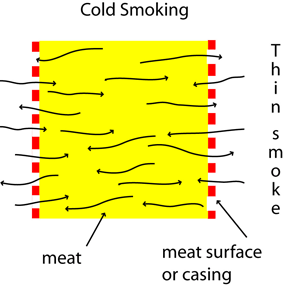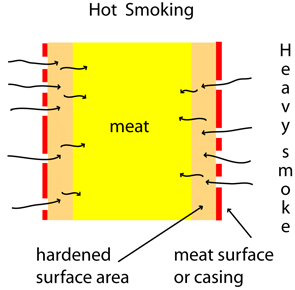Meats and Sausages
Hot Smoking
Hot smoking is the most common method of smoking. Continuous smoking at 112-140° F (45-60° C), 0.5-2 hours, 5-12% weight loss, heavy smoke. This is not recommended for large pieces of meat that are expected to be stored for a long time. Although it is the fastest method, there is not enough time for adequate smoke penetration. This results in higher moisture content, reducing the product’s shelf life. Hot smoking can be divided into three separate phases:
- Drying out the surface of the meat for 10-40 min at 112-130° F (45-55° C); some very light smoke is acceptable, although not necessary. Besides drying out the surface of the meat, the temperature speeds up nitrite curing. Keep in mind that the draft controls must be fully opened to eliminate any moisture residing inside the smoker. Applying smoke at temperatures higher than 130-140° F (54-60° C) will prematurely dry out the casings on the surface of the meat and will create a barrier to smoke penetration.
- This is the proper smoking stage at 112-140° F (45-60° C) for 30-90 min using medium to heavy smoke. The color becomes a light yellow to dark brown with a shade of red. In this state, the natural casings become strong and fit snugly on the sausages.
- Baking the sausage in a smokehouse at 176 - 185° F (80 - 85° C) for about 10-20 min. A thin smoke is allowed. Temperatures as high as 194° F (90° C) are permitted for a short period of time. Proteins are denatured in the outside layers of the product, but the inside remains raw, with temperatures reaching only 154 - 160° F (68 - 72° C). Natural casings fit very snugly, become shiny, and develop a few wrinkles. Acting as a barrier, the drier and stronger casings prevent the loss of juices.
Note: Baking in a smokehouse is optional. The majority of hot smoked sausages are cooked in water at 176° F (80° C), which makes it much faster and easier to maintain a steady temperature.
Because of a relatively short smoking time, hot smoked products should be kept in a refrigerator and consumed relatively quickly.
The above smoking times apply to a regular-sized sausage (32-26 mm), and smoking times for a thin meat stick or a large-diameter sausage have to be readjusted accordingly.
The majority of meats, such as hams, shoulders, loins, and hot smoked sausage after smoking are cooked in water (poached) at around 176° F (80° C) until the meat reaches 154-160° F (68-72° C) temperature inside.
Baking Hot Smoked Sausages in a Smokehouse
Hot smoked meats must still be fully cooked before consumption. They may as well be baked in a smokehouse since they are already there. The temperature in the last stages of the hot smoking process is gradually increased to 185 -194° F (85-90° C) until the inside of the meat reaches 154 - 160° F (68 - 72° C). At first, the meat's surface becomes dry, then its texture hardens, and the fat liquifies near the surface. This continues for about 1-3 hours until the meat reaches 160° F (72° C) internal temperature. It is worth noting that meat's internal temperature lags the temperature of a smokehouse by about 25 degrees. If the smokehouse temperature is 194° F (90° C), the internal temperature of the sausage will be 169° F (65° C). Of course, this lag of temperature will be affected by the diameter of the meat or sausage. Keep also in mind that after switching off the heat, the meat's internal temperature would still gain a degree or two, given that the surface temperature is much higher.
Baking meats offers some benefits as well disadvantages:
- They have better taste, flavor, and aroma than equivalent products cooked in water.
- Their texture is firmer.
- They exhibit some shine due to melted fat that settled on the surface
- They lose much more weight, up to 30%, than the products cooked in water.
- Their surface is shriveled and wrinkled.
- The sausages poached in water are smooth and plump. They also lose less weight, around 10-15%.
The Importance of Conditioning
Regardless of whether we smoke meats or sausages, their surface must feel dry to the touch. Whole meats like hams, butts or loins are usually cured in brine, injected with curing solution or both. They need to hang in a cooler until the moisture drains away and their surface is dry. In the case of a larger cut such as a ham, this conditioning/drying phase can last a day. Sausages are dry-cured but can also have a moist surface. However, they can dry out in 1-2 hours at room temperature or in a smokehouse at 115° F (46° C).
Note: It is extremely important that a smokehouse is dry inside. There could be rainy weather, the separate firebox can be wet, the walls of the metal smoker can be wet, wood logs, chips, or sawdust can be wet, etc. In such instances, the smokehouse must be heated until it is dry, and only then can the meats be smoked with dry chips.

Cold smoking allows total smoke penetration inside the meat. Very little hardening of the outside surface of the meat or casing occurs, and smoke penetrates the meat easily.

Hot smoking dries out the surface of the meat, creating a barrier to smoke penetration.
Warm Smoking
Continuous smoking at 77-104° F (25-40° C), from 4-48 hours depending on the diameter of the meat, humidity 80%, and medium smoke. The weight loss varies between 2-10%, with the difference being largely dependent on the time spent smoking. The surface of the product becomes quite dry, but the inside remains raw. Because of the warm smoke, the product receives more smoke in its outside layers. This dry second skin helps increase shelf life, as well as prevent the loss of its natural juices. The color ranges from yellow to brown and has a little shine due to some fat moving outward. Warm smoked products lose about 10-15% of their original weight.
Warm smoke temperatures lie within the Danger Zone (40-140° F, 5-60° C), which is the range of temperatures where all bacteria grow very fast. We may say that most bacteria love temperatures close to our body temperature, which is 36.6° C (98.6° F). Optimum growing conditions for the infamous Clostridium botulinum are 78-95° F (26-35° C), but it will still grow at 45° C (113° F). At those temperatures, the only protection we have is salt and sodium nitrite (Cure #1 or #2), which should be added to smoked meats. The reason for using cures (nitrite) is not only to eliminate the risk of food poisoning (Clostridium botulinum) but to obtain the desired color, achieve better flavor, and prevent the rancidity of fats.
Wet Smoking
Smoked meats lose around 10% moisture on average during the smoking process. This depends on temperature, the length of smoking, and humidity in the smokehouse. Eliminating moisture was important when the products were cold-smoked for preservation purposes. Nowadays, the importance of preserving meats by dehydration plays a secondary role; besides, losing moisture means decreasing weight, and that, in turn, leads to decreased profits. To prevent this loss, commercial manufacturers pump meats with water and recirculate moist air through the smokehouse. Ready-made charcoal briquettes or electric heating elements produce no moisture, so placing a water-filled pan inside the smoker is of some help. This method is very common when barbecuing or smoking meats in commercially produced little smokers. These are enclosed units that don’t receive a steady supply of air. Secondly, in arid desert areas such as Arizona or Nevada, humidity can be as low as 10%. Delivering hot smoke under such conditions will soon dry the meat's or sausage's surface area, which becomes a barrier to continuous smoking.
Fresh air contains moisture, which cools sausage casings or the surface of the meat. When smoking over an open fire, lots of fresh air enters the smoker and keeps the meat from drying out. No matter how pretty a small factory unit may be, it will not be able to perform the same duty without a little help from a water pan. As the water boils at sea level at the constant temperature of 212° F (100° C), placing a water-filled pan inside of a small smoker will also help regulate the temperature inside by keeping it no higher than 212° F (100° C). Excessive heat will start to boil water. Bear in mind that 212° F (100° C) is too high a temperature for smoking quality meats and sausages. In short, wet smoking is the type of smoking that employs a water dish placed inside of the smoker to increase humidity levels. Dampening wood chips in water one hour before smoking will produce a similar effect using any kind of smoker.
When using wood, it always has at least 20% moisture, even when perfectly dried on the outside. During the first stage of combustion, this wood dries out, and any remaining moisture evaporates with the smoke into the chamber. Once the wood has burned out, the remaining charcoal has no water left, and the only moisture the smokehouse gets is brought by the outside air. In dry climates known for little humidity, the smoked product will benefit from extra moisture. Keep in mind that the surface of smoked meats or sausages must not be wet during the smoking process.
Summary of smoking methods
- The longer the smoking time, the bigger the loss of moisture and the higher the proportion of salt. The product becomes drier and saltier but achieves longer shelf-keeping qualities.
- A supply of fresh air is needed during smoking, which is normally controlled with a damper. Exhaust smoke also needs a damper control; otherwise, tar and other unburned wood particles may start to accumulate, affecting the look and the taste of the product.
- The higher the smoke temperature, the shorter the smoking time and the shorter its shelf life.
- The lower the smoke temperature, the better the smoke diffusion and the longer the time of smoking. This directly leads to better taste and longer shelf life.
There is no steadfast rule that dictates exact temperature ranges for different types of smoking. Different books mention slightly different temperatures. A few degrees, one way or the other should not create any problem as long as the hot smoking upper temperature limit is not crossed. Crossing this limit will significantly affect the look and the taste of the sausage.
















